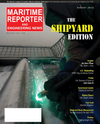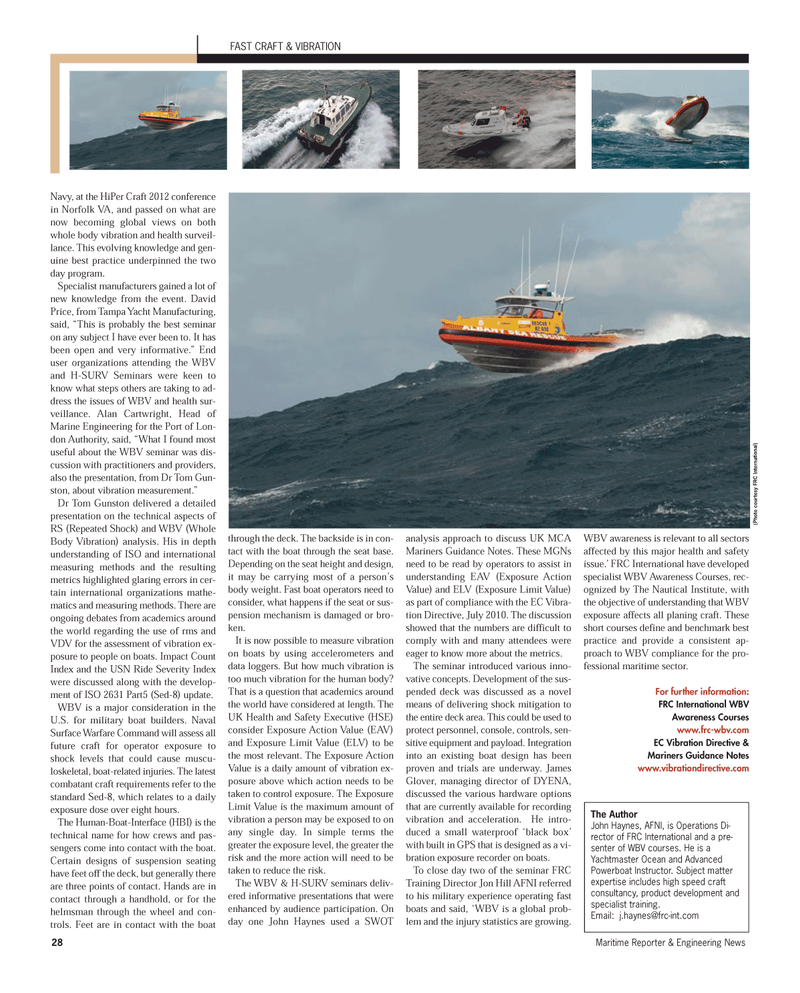
Page 28: of Maritime Reporter Magazine (August 2012)
The Shipyard Edition
Read this page in Pdf, Flash or Html5 edition of August 2012 Maritime Reporter Magazine
28Maritime Reporter & Engineering News Navy, at the HiPer Craft 2012 conference in Norfolk VA, and passed on what are now becoming global views on both whole body vibration and health surveil- lance. This evolving knowledge and gen- uine best practice underpinned the two day program.Specialist manufacturers gained a lot of new knowledge from the event. David Price, from Tampa Yacht Manufacturing, said, ?This is probably the best seminaron any subject I have ever been to. It has been open and very informative.? End user organizations attending the WBV and H-SURV Seminars were keen to know what steps others are taking to ad- dress the issues of WBV and health sur- veillance. Alan Cartwright, Head of Marine Engineering for the Port of Lon-don Authority, said, ?What I found most useful about the WBV seminar was dis- cussion with practitioners and providers, also the presentation, from Dr Tom Gun- ston, about vibration measurement.? Dr Tom Gunston delivered a detailed presentation on the technical aspects ofRS (Repeated Shock) and WBV (Whole Body Vibration) analysis. His in depth understanding of ISO and internationalmeasuring methods and the resultingmetrics highlighted glaring errors in cer- tain international organizations mathe- matics and measuring methods. There are ongoing debates from academics aroundthe world regarding the use of rms and VDV for the assessment of vibration ex- posure to people on boats. Impact CountIndex and the USN Ride Severity Index were discussed along with the develop- ment of ISO 2631 Part5 (Sed-8) update. WBV is a major consideration in theU.S. for military boat builders. Naval Surface Warfare Command will assess all future craft for operator exposure to shock levels that could cause muscu- loskeletal, boat-related injuries. The latest combatant craft requirements refer to thestandard Sed-8, which relates to a dailyexposure dose over eight hours. The Human-Boat-Interface (HBI) is the technical name for how crews and pas- sengers come into contact with the boat.Certain designs of suspension seatinghave feet off the deck, but generally there are three points of contact. Hands are incontact through a handhold, or for thehelmsman through the wheel and con-trols. Feet are in contact with the boatthrough the deck. The backside is in con- tact with the boat through the seat base.Depending on the seat height and design,it may be carrying most of a person?s body weight. Fast boat operators need to consider, what happens if the seat or sus- pension mechanism is damaged or bro-ken. It is now possible to measure vibration on boats by using accelerometers anddata loggers. But how much vibration is too much vibration for the human body?That is a question that academics aroundthe world have considered at length. The UK Health and Safety Executive (HSE) consider Exposure Action Value (EAV) and Exposure Limit Value (ELV) to be the most relevant. The Exposure Action Value is a daily amount of vibration ex- posure above which action needs to be taken to control exposure. The Exposure Limit Value is the maximum amount of vibration a person may be exposed to on any single day. In simple terms the greater the exposure level, the greater the risk and the more action will need to betaken to reduce the risk. The WBV & H-SURV seminars deliv- ered informative presentations that were enhanced by audience participation. Onday one John Haynes used a SWOT analysis approach to discuss UK MCAMariners Guidance Notes. These MGNs need to be read by operators to assist inunderstanding EAV (Exposure Action Value) and ELV (Exposure Limit Value) as part of compliance with the EC Vibra- tion Directive, July 2010. The discussion showed that the numbers are difficult to comply with and many attendees were eager to know more about the metrics. The seminar introduced various inno- vative concepts. Development of the sus- pended deck was discussed as a novel means of delivering shock mitigation to the entire deck area. This could be used to protect personnel, console, controls, sen-sitive equipment and payload. Integration into an existing boat design has been proven and trials are underway. James Glover, managing director of DYENA, discussed the various hardware options that are currently available for recording vibration and acceleration. He intro-duced a small waterproof ?black box? with built in GPS that is designed as a vi- bration exposure recorder on boats. To close day two of the seminar FRC Training Director Jon Hill AFNI referred to his military experience operating fast boats and said, ?WBV is a global prob-lem and the injury statistics are growing. WBV awareness is relevant to all sectors affected by this major health and safety issue.? FRC International have developed specialist WBV Awareness Courses, rec- ognized by The Nautical Institute, with the objective of understanding that WBV exposure affects all planing craft. These short courses define and benchmark best practice and provide a consistent ap- proach to WBV compliance for the pro- fessional maritime sector. For further information: FRC International WBV Awareness Courses www.frc-wbv.com EC Vibration Directive & Mariners Guidance Notes www.vibrationdirective.com FAST CRAFT & VIBRATION The AuthorJohn Haynes, AFNI, is Operations Di-rector of FRC International and a pre- senter of WBV courses. He is aYachtmaster Ocean and Advanced Powerboat Instructor. Subject matter expertise includes high speed craft consultancy, product development and specialist training.Email: [email protected] (Photo courtesy FRC International) MR#8 (26-33):MR Template 8/8/2012 11:55 AM Page 28

 27
27

 29
29
